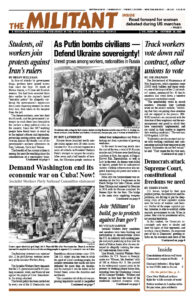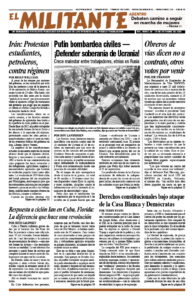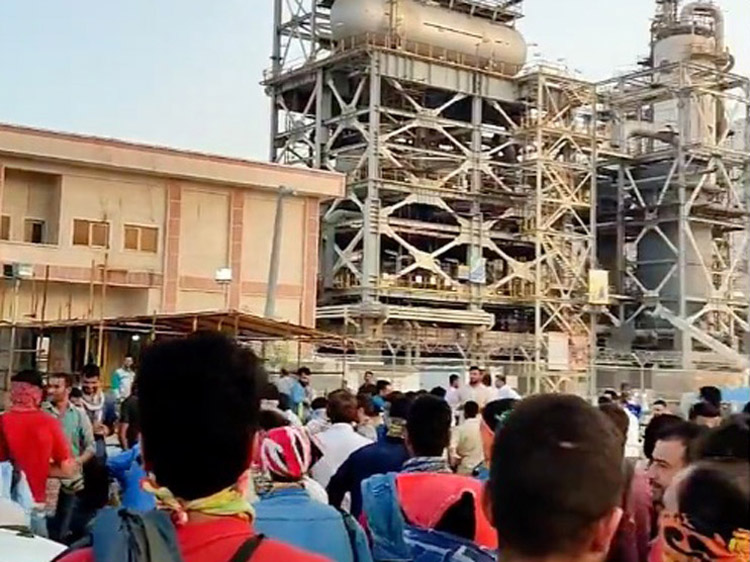In face of attacks by government thugs, protests have spread across Iran since the Sept. 16 death of Mahsa Amini, a 22-year-old Kurdish woman. She had been arrested three days earlier by the regime’s hated “morality police” for allegedly violating the government’s oppressive dress code requiring women to cover their hair, then taken to the hospital from the jail.
The demonstrations, now into their fourth week, and the government’s attempts to crush them have brought to the surface a deep political crisis in the country. Since late 2017 working people have found ways to stand up to the regime’s abuses and repression, protesting soaring prices and demonstrating against the deadly cost of the government’s military adventures in Iraq, Lebanon, Syria and Yemen.
The breadth of the current actions is among the most far-reaching since the consolidation of a reactionary bourgeois, clerical regime in 1983, during a counterrevolution aimed at pushing back workers, farmers, women and oppressed nationalities who carried out the popular Iranian Revolution four years earlier. The 1979 revolution rid Iran of the brutal rule of the U.S.-backed shah, opened space for the toilers to fight in their own interests, and brought working people into action, establishing workers councils in the factories, fields and refineries.
When schools opened this fall thousands of students from universities, high schools and even primary schools walked out as protests expanded.
“Get lost!” chanted female students at Alzahra University in Tehran when Iranian President Ebrahim Raisi visited the campus Oct. 3. He read a poem equating protesters with flies.
Videos posted by the Coordinating Council of Iranian Teachers Trade Union Associations shows high school students across the country waving their headscarves and singing and chanting as they march. One shows plainclothes cops shoving women marchers and demonstrators standing up to their thuggery.
At a high school in Gohardasht Karaj, female students removed their headscarfs and forced the director of education to leave Oct. 3. Two days later in a similar protest at a girls’ school in Tehran, students rallied against a visit by a representative of the Basij paramilitary force.
“Primary school students in Mahabad,” the teachers trade union wrote, “invited people to participate in the protests, distributing handwritten notices” urging them to “shout for your rights.” Bystanders applauded their marches.
Workers at a petrochemical complex in Asaluyeh, southern Iran, went on strike Oct. 10. Iranian news agency Tasnim described it as a wage dispute. The Organizing Council of Oil Contract Workers threatened to launch a nationwide strike if strikers who have been arrested are not released. “We once again express our solidarity with the people’s protest on the streets against the killing of Mahsa,” the union said, and called for the “immediate release of those arrested during the recent protests and all political prisoners.”
The song “Baraye” by 25-year-old Shervin Hajipour, with lyrics about Iranians’ desire “for freedom,” is sung by many demonstrators. Its online video was viewed over 40 million times in two days until authorities took it down and put Hajipour in prison for a week.
Shop keepers in many cities have also shutdown in support of the protests.
Targeting Kurds, other minorities
Some of the sharpest confrontations are taking place in Sistan-Baluchistan, Iran’s poorest province, where the majority of the country’s Baloch population of over 2 million live; in Khuzestan, where most of Iran’s 1.5 million ethnic Arabs live; and in Iranian Kurdistan, home to a majority of the country’s 10 million Kurds. Police forces in Sistan-Baluchistan killed over 80 people Sept. 30-Oct. 6, firing with live ammunition on demonstrations of hundreds.
The Iranian regime also continues to fire ballistic missiles and suicide drones into the Erbil and Sulaimaniyah provinces of the neighboring Kurdistan region of Iraq. At least 16 people, including one child, were killed and over 50 injured in these attacks, Rudaw news agency reported. The Islamic Revolutionary Guard Corps threatened to invade Iraqi Kurdistan Oct. 9 if the Kurdistan Regional Government there didn’t expel Iranian Kurdish organizations Tehran blames for inciting the countrywide protests in Iran.
Iranian authorities have arrested at least 1,900 protesters nationwide. Demonstrations have been reported in nearly 100 cities, towns and villages. The Norway-based Iran Human Rights group says more than 185 people, including at least 19 children, had been killed, with hundreds more injured.
“They can kill us, arrest us but we will not remain silent anymore,” a university student on his way to join protests in Tehran told Reuters Oct. 8. “Our classmates are in jail. How can we remain silent?”
In an Oct. 3 speech at a graduation ceremony for military recruits, Supreme Leader Ayatollah Ali Khamenei blamed U.S. and Israeli government agents for initiating the protests. “These riots were planned,” Khamenei insisted.
As part of the government’s clampdown, Iran’s state media released a video Oct. 6 showing two teachers from France “confessing” to being spies fomenting unrest in Iran. The teachers, Cecile Kohler, president of the National Federation of Education, Culture and Vocational Training in France, and Jacques Paris, were arrested in May. They were visiting Iran on tourist visas and met with leaders of Iran’s teachers’ unions.
In response, the Tehran bus workers union spoke out against the frame-up, saying it “firmly condemns the publication of lies by the government and forced confessions under threats and torture.”
Workers and farmers in Iran bear the brunt of the worldwide capitalist economic crisis, compounded by U.S.-led sanctions. Inflation has risen by 50% over the year, and the country’s currency, the rial, has fallen to its lowest level ever.
Actions in solidarity with the protesters in Iran have been held in cities around the world, including New York, Los Angeles, Toronto, London, Paris, Tokyo, and Kabul, Afghanistan. In Israel, about 100 people, most of them women, rallied in Jerusalem Oct. 6. They held signs in Hebrew, English and Farsi. Many of those participating were of Persian descent.


